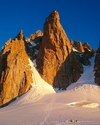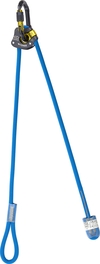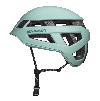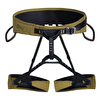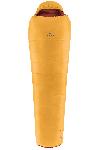Let's free our crags from in-situ quickdraws!
Maurizio Oviglia, the man responsible for hundeds of new routes all across Italy, reflects about the use and habit of leaving in-situ quickdraws on sport routes. This habit is spreading to easier routes and the implications are far deeper than a simple question of aesthetics.

 1 / 4
1 / 4
Crags and in-situ gear
 arch. Maurizio Oviglia
arch. Maurizio Oviglia
With the growth in popularity in sport climbing, crags in Italy have increasingly become the target of a series of new "habits and customs" aimed officially at helping climbers as they work their hard projects, but which, at the end of the day, are nothing more than an additional "discount" since they facilitate the redpoint. If this were the only reason for ill-feeling then one could ignore these "bad habits" seeing that, at the end of the day, anyone can do as they choose at the crags. There are no judges to control us and we know all to well that the few rules we adhere to are a far cry from being objective. On the contrary, they have proven to be interpretable in different ways depending on the location and the moment in time.
What was once considered not valid is nowadays considered OK, or rather it's generally accepted. But what is considered valid in one area might not be in another, etc. We also know that the concept of a redpoint isn't unequivocal. All too often we witness redpoint ascent with quickdraws in place, at times extended out of proportion, with the first, second or even the third pre-clipped. Perhaps the climber even grabs the chain which has been extended... and the list could go on for ever!
We don't intend to discuss redpoint ethics but we simply want to observe that these "minor discounts", even if generally accepted, harm the freedom of others who want to climb a route in a different style (which one could define as being good style). When they limit the freedom of others, then these practices must be considered "bad habits" that must be discouraged. In particular I'm referring to the bad habit of leaving tick marks on every hold and leaving in-situ quickdraws on the routes you're trying, not only for a couple of weeks but at times even years.
Tick marks (sometimes even left with felt-tip pen or with coloured chalk) enormously facilitate an on-sight (sometimes even making it nonsensical), while in-situ quickdraws on personal projects impede others from climbing the route with their own gear and clipping the bolts (as one should do in a redpoint ascent - we all know that this makes things harder). Worse still, this practice touches on the safety of those climbing a route.
As you can make out from the photos, quickdraws left on routes deteriorate, often don't close properly or even, when they've been on a route for more than a year, they start to flake and become extremely dangerous. You might say that all one needs to do is swap them... but even if you want to do so, at times it's impossible because many climbers have had the great idea (which at times they're even proud of) of fixing a maillon-rapide to the quickdraw. This corodes extremely quickly (no one uses stainless steel maillon-rapide as they cost too much) meaning that they can only be removed by using bolt cutters!
In short, those who want to try to on-sight a route not only cannot do so with their own gear, but at times they have to climb using ancient and unsafe gear. If you want to ignore the ethical aspects of extending quickdraws up to three or four times (as is often the case in many Italian crags) I don't see why everyone has to conform and why, if one really wants to leave in-situ gear, people don't remove their quickdraws once they've sent their projects instead of leaving them there forever.
I'm certain that at this point some will object, saying that quickdraws are usually left in-situ only on really hard routes... Hold tight, because nowadays they're often to be found on 7a's, which is a grade that many are capable of on-sighting. Others have written to me saying that in-situ gear in steep caves are useful and at times even indispensable since they enable the leader to recuperate his or her quickdraws without having to toprope the route to clean it. It's true that there's always been the odd strategically placed quickdraw. But this used to be checked and swapped regularly and since it was only one, it didn't constitute a danger. But it's a completely different kettle of fish leaving quickdraws on the entire project, regardless of its angle!
I've heard that there are crags (Grotti for example) where in-situ quickdraws are tolerated on routes 7c or harder (left on easier routes they simply disappear)... This is a solution, too, but I continue to hope that climbers will realise, without the threat of having their gear stolen, that the crags are there for everyone and as such they need to be kept clean. Without wishing to point a finger and dictating ethics, this is simply a question of respect which I'm certain climbers in the future will adhere to...
Maurizio Oviglia
www.pietradiluna.com
What was once considered not valid is nowadays considered OK, or rather it's generally accepted. But what is considered valid in one area might not be in another, etc. We also know that the concept of a redpoint isn't unequivocal. All too often we witness redpoint ascent with quickdraws in place, at times extended out of proportion, with the first, second or even the third pre-clipped. Perhaps the climber even grabs the chain which has been extended... and the list could go on for ever!
We don't intend to discuss redpoint ethics but we simply want to observe that these "minor discounts", even if generally accepted, harm the freedom of others who want to climb a route in a different style (which one could define as being good style). When they limit the freedom of others, then these practices must be considered "bad habits" that must be discouraged. In particular I'm referring to the bad habit of leaving tick marks on every hold and leaving in-situ quickdraws on the routes you're trying, not only for a couple of weeks but at times even years.
Tick marks (sometimes even left with felt-tip pen or with coloured chalk) enormously facilitate an on-sight (sometimes even making it nonsensical), while in-situ quickdraws on personal projects impede others from climbing the route with their own gear and clipping the bolts (as one should do in a redpoint ascent - we all know that this makes things harder). Worse still, this practice touches on the safety of those climbing a route.
As you can make out from the photos, quickdraws left on routes deteriorate, often don't close properly or even, when they've been on a route for more than a year, they start to flake and become extremely dangerous. You might say that all one needs to do is swap them... but even if you want to do so, at times it's impossible because many climbers have had the great idea (which at times they're even proud of) of fixing a maillon-rapide to the quickdraw. This corodes extremely quickly (no one uses stainless steel maillon-rapide as they cost too much) meaning that they can only be removed by using bolt cutters!
In short, those who want to try to on-sight a route not only cannot do so with their own gear, but at times they have to climb using ancient and unsafe gear. If you want to ignore the ethical aspects of extending quickdraws up to three or four times (as is often the case in many Italian crags) I don't see why everyone has to conform and why, if one really wants to leave in-situ gear, people don't remove their quickdraws once they've sent their projects instead of leaving them there forever.
I'm certain that at this point some will object, saying that quickdraws are usually left in-situ only on really hard routes... Hold tight, because nowadays they're often to be found on 7a's, which is a grade that many are capable of on-sighting. Others have written to me saying that in-situ gear in steep caves are useful and at times even indispensable since they enable the leader to recuperate his or her quickdraws without having to toprope the route to clean it. It's true that there's always been the odd strategically placed quickdraw. But this used to be checked and swapped regularly and since it was only one, it didn't constitute a danger. But it's a completely different kettle of fish leaving quickdraws on the entire project, regardless of its angle!
I've heard that there are crags (Grotti for example) where in-situ quickdraws are tolerated on routes 7c or harder (left on easier routes they simply disappear)... This is a solution, too, but I continue to hope that climbers will realise, without the threat of having their gear stolen, that the crags are there for everyone and as such they need to be kept clean. Without wishing to point a finger and dictating ethics, this is simply a question of respect which I'm certain climbers in the future will adhere to...
Maurizio Oviglia
www.pietradiluna.com
Note:
| Links Planetmountain | |
| News Maurizio Oviglia | |
Latest news
Expo / News
Expo / Products
Fast hiking shoes by AKU
Adjustable lanyard for mountaineering and rock climbing by Climbing Technology
Light climbing helmet with kevlar reinforcements.
High-end one-buckle climbing harness combining comfort and light weight.
Light and flexible hiking shoeit
Down sleeping bag for multi‑season trekking.



 Copia link
Copia link

